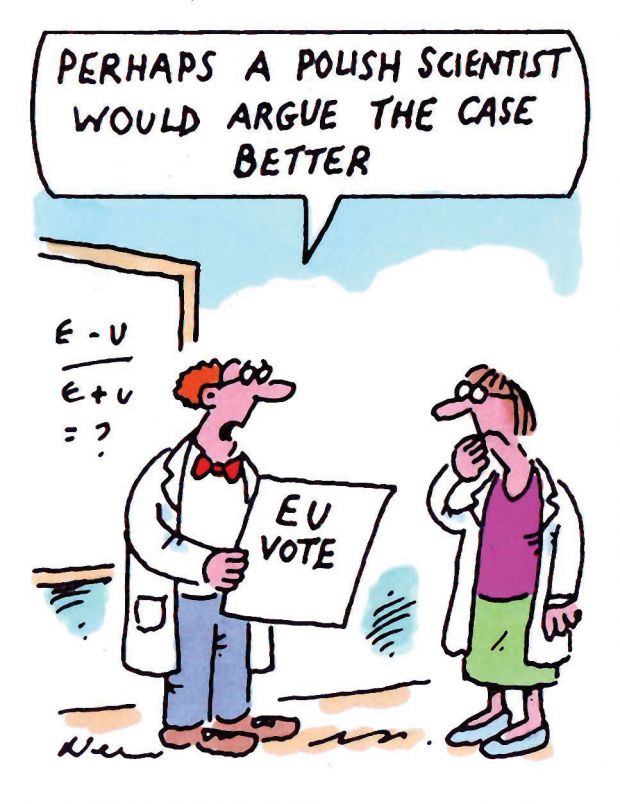
A group of scientists and advocates for science published a letter in The Times on 22 May setting out “our support for the EU, its scientific direction, and [the UK’s] continued membership”. The letter – signed by figures including Sir Paul Nurse, Nature editor-in-chief Philip Campbell and Sir Steve Smith, vice-chancellor of the University of Exeter – says that the coming EU referendum “will need debate enriched by perspectives from all concerned, including the science community”. Arguing that the perspective of the scientific community is pro-EU, the letter urges Jo Johnson, the universities and science minister, to “ensure this is communicated robustly from his position”. It remains to be seen what hearing science will receive in a public debate that many expect to focus on three issues: immigration, immigration and immigration.
The University of Edinburgh said that it “deeply regrets” an incident in which a student was pushed to the ground by a security guard. Footage of the incident, which happened during an occupation of a university building in protest at the university’s decision not to divest fully from fossil fuels, shows the guard placing his hand around the demonstrator’s neck. An Edinburgh spokesman said that the university “deeply regrets the unfortunate incident” and that it would “continue to support the right of students to peacefully and lawfully demonstrate”. On 21 May, a Police Scotland spokeswoman said that two men had been arrested and charged.
“The prominent climate change sceptic Viscount Monckton of Brenchley has complained to police after a tombstone engraved with his name was exhibited at Anglia Ruskin University,” reported The Independent on 20 May. The piece features the names of six sceptics, also including Lord Lawson and journalist James Delingpole, “chiselled under the words ‘Lest We Forget Those Who Denied’”, the newspaper said. “A constant stream of engine oil runs over the memorial.” A spokesman for the viscount said that “a complaint had been made to police about the university press release, which he says reinforced the representation of the death threat in the art work”, The Independent continued. The work, by third-year fine art student Ian Wolter, prompted a Daily Mail article by Mr Delingpole noting what he saw as a salient and distasteful fact: Anglia Ruskin is “formerly Anglia Polytechnic”.
It has been a mixed week for Oxbridge traditionalists. On 22 May, The Daily Telegraph reported that more than 75 per cent of students at the University of Oxford had voted to keep the requirement for formal dress, known as sub fusc, to be worn for exams despite claims from some that it was archaic and elitist. On the other hand, The Independent reported on 20 May that more than 900 undergraduates at the University of Cambridge have signed a petition calling for an end to publicly displaying their exam results on the grounds that it promotes a “culture of shaming”. Then the Daily Mail reported on 23 May that Cambridge’s “notorious” men-only drinking society the Gentleman Wyverns has restored the tradition of female jelly wrestling at its annual garden party. A petition had put paid to the “sexist, misogynist and completely inappropriate” practice two years ago. But this time chaps will be permitted to join the “bikini-clad” female students “cavorting in a paddling pool of jelly”. Perhaps they could all wear full sub fusc?
Academics have reacted coolly to a botanist’s claims to have unearthed the only known picture of Shakespeare drawn during his lifetime. The Independent reported on 19 May that historian Mark Griffiths found the image on the title page of a 1598 book called The Herball or Generall Historie of Plantes. The bearded figure holding flowers and an ear of sweetcorn is supposedly unmasked as the Swan of Avon by numerous typically Elizabethan cryptic clues that amount to “a simple equation”. Edward Wilson, emeritus fellow of Worcester College, Oxford, called the revelation “sensational”, but colleagues were less convinced. Michael Dobson, director of the University of Birmingham’s Shakespeare Institute, called it a “hallucination”. It can only be a matter of time before an academic somewhere claims that the picture is actually of the 17th Earl of Oxford.
Register to continue
Why register?
- Registration is free and only takes a moment
- Once registered, you can read 3 articles a month
- Sign up for our newsletter
Subscribe
Or subscribe for unlimited access to:
- Unlimited access to news, views, insights & reviews
- Digital editions
- Digital access to THE’s university and college rankings analysis
Already registered or a current subscriber?